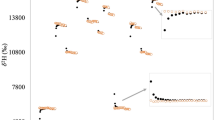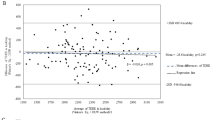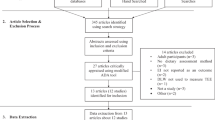Abstract
Background/Objectives
The doubly labeled water (DLW) method is the gold standard methodology for determination of free-living, total daily energy expenditure (TEE). However, there is no single accepted approach for either the sampling protocols (daily vs. two-point, in which samples are collected after dosing and at the end of the measurement period) or the calculations used in the determination of the rate of carbon dioxide production (rCO2) and TEE. Moreover, fluctuations in natural background abundances introduce error in the calculation of rCO2 and TEE. The advent of new technologies makes feasible the possibility of including additional isotope measures (17O) to account for background variation, which may improve accuracy.
Subjects/Methods
Sixteen subjects were studied for 7 consecutive days in a whole-room indirect calorimeter (IC) with concurrent measurement of TEE by DLW. Daily urine samples were obtained and isotope ratios were determined using off-axis integrated cavity output spectroscopy (OA-ICOS).
Results
We determined the best combination of approaches for estimating dilution spaces and elimination rates and calculated average daily volume of carbon dioxide production (VCO2) using six different published equations. Using this best combination, multi-point fitting of isotope elimination rates using the daily urine samples substantially improved the average precision (4.5% vs. 6.0%) and accuracy (−0.5% vs. −3.0%) compared with the two-point method. This improvement may partly reflect the less variable day-to-day chamber measurements of energy expenditure. Utilizing 17O measurements to correct for errors due to background isotope fluctuations provided additional but minor improvements in precision (4.2% vs. 4.5%) and accuracy (0.2% vs. 0.5%).
Conclusions
This work shows that optimizing sampling and calculation protocols can improve the accuracy and precision of DLW measurements.
This is a preview of subscription content, access via your institution
Access options
Subscribe to this journal
Receive 12 print issues and online access
$259.00 per year
only $21.58 per issue
Buy this article
- Purchase on Springer Link
- Instant access to full article PDF
Prices may be subject to local taxes which are calculated during checkout






Similar content being viewed by others
References
Lifson N, McClintock R. Theory of the use of the turnover rates of body water for measuring energy expenditure. J Theor Biol 1966;12:46–74.
Speakman JR. Doubly labelled water: theory and practice. London: Chapman and Hall; 1997.
Weir JB. New methods for calculating metabolic rate with special reference to protein metabolism. J Physiol 1949;109:1–9.
Schoeller DA, Ravussin E, Schutz Y, Acheson KJ, Baertschi P, Jequier E. Energy expenditure by doubly labeled water: validation in humans and proposed calculation. Am J Physiol 1986;250(5 Pt 2):R823–30.
Speakman JR, Nair KS, Goran MI. Revised equations for calculating CO2 production from doubly labeled water in humans. Am J Physiol 1993;264(6 Pt 1):E912–7.
Pontzer H. Method and rationale for recalculating dilution spaces to a single, common time point in doubly labeled water studies. Eur J Clin Nutr 2018;72:1620–4.
Roberts SB, Dietz W, Sharp T, Dallal GE, Hill JO. Multiple laboratory comparison of the doubly labeled water technique. Obes Res 1995;3(Suppl 1):3–13.
Klein PD, James WP, Wong WW, Irving CS, Murgatroyd PR, Cabrera M, et al. Calorimetric validation of the doubly-labelled water method for determination of energy expenditure in man. Hum Nutr Clin Nutr 1984;38:95–106.
Speakman JR, Racey PA. Measurement of CO2 production by the doubly labeled water technique. J Appl Physiol 1986;61:1200–2.
Speakman JR, Racey PA. Doubly labelled water: errors in the evaluation of oxygen isotope turnover due to temporal variation in CO2 production do not always covary with dilution space estimate. J Theor Biol 1989;141:547–56.
Speakman JR, Racey PA. The equilibrium concentration of oxygen-18 in body water: Implications for the accuracy of the doubly-labelled water technique and a potential new method of measuring RQ in free-living animals. J Theor Biol 1987;127:79–95.
Horvitz MA, Schoeller DA. Natural abundance deuterium and 18-oxygen effects on the precision of the doubly labeled water method. Am J Physiol Endocrinol Metab 2001;280:E965–72.
Berman ES, Melanson EL, Swibas T, Snaith SP, Speakman JR. Inter- and intraindividual correlations of background abundances of (2)H, (18)O and (17)O in human urine and implications for DLW measurements. Eur J Clin Nutr 2015;69:1091–8.
Speakman JR. The role of technology in the past and future development of the doubly labelled water method. Isot Environ Health Stud 2005;41:335–43.
Speakman JR, Krol E. Comparison of different approaches for the calculation of energy expenditure using doubly labeled water in a small mammal. Physiol Biochem Zool 2005;78:650–67.
Berman ES, Fortson SL, Snaith SP, Gupta M, Baer DS, Chery I, et al. Direct analysis of delta2H and delta18O in natural and enriched human urine using laser-based, off-axis integrated cavity output spectroscopy. Anal Chem 2012;84:9768–73.
Berman ES, Levin NE, Landais A, Li S, Owano T. Measurement of delta18O, delta17O, and 17O-excess in water by off-axis integrated cavity output spectroscopy and isotope ratio mass spectrometry. Anal Chem 2013;85:10392–8.
Melanson EL, Swibas T, Kohrt WM, Catenacci VA, Creasy SA, Plasqui G, et al. Validation of the doubly labeled water method using off-axis integrated cavity output spectroscopy and isotope ratio mass spectrometry. Am J Physiol Endocrinol Metab 2018;314:E124–30.
Coward WA, Prentice AM. Isotope method for the measurement of carbon dioxide production rate in man. Am J Clin Nutr 1985;41:659–63.
Schoeller DA. Measurement of energy expenditure in free-living humans by using doubly labeled water. J Nutr 1988;118:1278–89.
Racette SB, Schoeller DA, Luke AH, Shay K, Hnilicka J, Kushner RF. Relative dilution spaces of 2H- and 18O-labeled water in humans. Am J Physiol 1994;267(4 Pt 1):E585–90.
Sagayama H, Yamada Y, Racine NM, Shriver TC, Schoeller DA, Group DLWS. Dilution space ratio of 2H and 18O of doubly labeled water method in humans. J Appl Physiol 2016;120:1349–54.
Speakman JR. Calculation of CO2 production in doubly-labelled water studies. J Theor Biol 1987;126:101–4.
Speakman JR. How should we caclulate CO2 production in doubly labeled water studies of animals. Func Ecol 1993;7:746–50.
Krol E, Speakman JR. Isotope dilution spaces of mice injected simultaneously with deuterium, tritium and oxygen-18. J Exp Biol 1999;202(Pt 20):2839–49.
Ritz P, Johnson PG, Coward WA. Measurements of 2H and 18O in body water: analytical considerations and physiological implications. Br J Nutr 1994;72:3–12.
Funding
This work was supported by an NIH Small Business Innovation (SBIR) Research Grant (R44 DK093362), as well as support from the Colorado Nutrition and Obesity Research Center (P30 DK048520) and the Colorado Clinical and Translational Science Institute (UL1 RR025780). ELM is also supported by resources from the Geriatric Research, Education, and Clinical Center at the Denver VA Medical Center. JRS was supported by a 1000 Talents award from the Chinese government and a Wolfson merit award from the UK royal society.
Author information
Authors and Affiliations
Corresponding author
Ethics declarations
Conflict of interest
At the time the research was conducted, ESFB was employed by ABB/Los Gatos Research, the company that manufactures the OA-ICOS analyzer used for the analyses in this paper. The others declare that they have no conflict of interest.
Additional information
Publisher’s note: Springer Nature remains neutral with regard to jurisdictional claims in published maps and institutional affiliations.
Rights and permissions
About this article
Cite this article
Berman, E.S.F., Swibas, T., Kohrt, W.M. et al. Maximizing precision and accuracy of the doubly labeled water method via optimal sampling protocol, calculation choices, and incorporation of 17O measurements. Eur J Clin Nutr 74, 454–464 (2020). https://doi.org/10.1038/s41430-019-0492-z
Received:
Revised:
Accepted:
Published:
Issue Date:
DOI: https://doi.org/10.1038/s41430-019-0492-z
This article is cited by
-
Criterion validity of wrist accelerometry for assessing energy intake via the intake-balance technique
International Journal of Behavioral Nutrition and Physical Activity (2023)
-
Combining accelerometry with allometry for estimating daily energy expenditure in joules when in-lab calibration is unavailable
Movement Ecology (2023)
-
First use of triply labelled water analysis for energy expenditure measurements in mice
Scientific Reports (2022)
-
Whole-body insulin resistance and energy expenditure indices, serum lipids, and skeletal muscle metabolome in a state of lipoprotein lipase overexpression
Metabolomics (2021)



